On a visit to Rome, a good friend who lived there promised she would show me something amazing that many tourists never find. It is the Piccolo Museum of the Poor Souls in Purgatory. It is comprised of one large display case on a single wall tucked in the back of the Chiesa del Sacro Cuore del Suffragio – the Church of the Sacred Heart of the Suffrage.
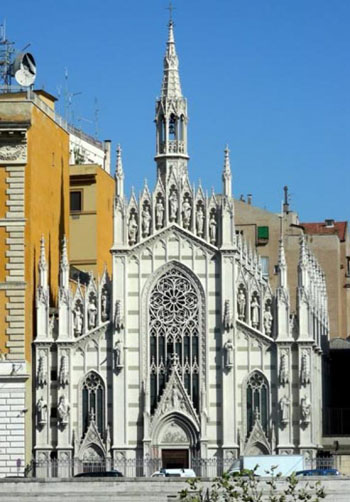
The Church of the Sacred Heart in Rome, dedicated to the Poor Souls
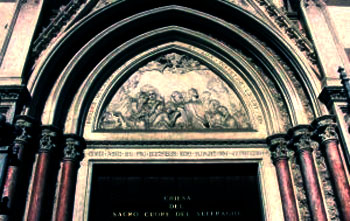
It is just a short distance from the Vatican, on the street that runs parallel to the Tiber, the Lungotevere. If you are in Rome, it is well worth taking the time to see it.
The Church itself is a brilliant gothic jewel amid the otherwise heavy Renaissance churches in Rome. Inside, its three naves are crowned with altars to the Saints: outside, its central tower soars above the rest, points to Heaven moving the soul upward.
Over the entryway is a marble relief sculpture of the Poor Souls, who also look upward with hope, for Heaven is their destined home after their time of suffering is over. They look upward seeking relief. Catholic doctrine teaches us that Purgatory is a place of suffering, where souls atone for their sins.
The artifacts in the Museum attest to these truths. Each glassed display holds a different item – Scriptures, prayer books, a tabletop, an article of clothing – that bears the singed marks of the hands of souls in Purgatory.
These souls were permitted by God to return to earth to ask family members or friends for prayers or Masses and leave behind some evidence of their suffering. Thus, they give testimony for Catholics of all epochs that Purgatory exists, a physical place of fire and suffering.
Origin of the Museum
In the 19th century, under the influence of the Enlightenment, ‘modern’ minds were already doubting these truths of the Catholic Faith. One good defense of the Faith came from a French priest, Fr. Victor Jouet of the Order of the Sacred Heart - founded in 1854 by Fr. Jules Chevalier with the purpose of saying Masses and prayers for the repose of the Poor Souls.
In 1897, the Order in Rome had a chapel dedicated to Our Lady of the Rosary. On September 15, the chapel caught fire. When it subsided, the clear image of a suffering face, portraying a soul in Purgatory, was noticed on one charred wall. This impressed Fr. Jouet deeply, and he became interested in finding other concrete evidence of manifestations of the souls in Purgatory to those living on earth.
With the support of Pope St. Pius X, Fr. Jouet traveled throughout Belgium, France, Germany and Italy, collecting these relics – proofs of the existence of Purgatory – to house in the Gothic Church that the Order was building to replace their chapel in Rome.
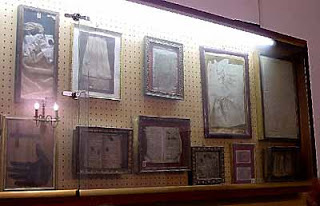
Part of the modest display case that composes the small Museum
The Small Museum officially opened to the public the same year the Church opened for worship in 1917. Fr. Jouet’s successor, Fr. Gilla Gremigni, closed the museum in 1920, supposedly to give him time to authenticate the pieces. It remained shut for 30 years.
Today, the pilgrim to Rome can still see the dozen or so approved exhibits, but perhaps not for long. In the 1990s there was discussion at the Vatican about closing the Museum. In view of the New Theology that has triumphed since Vatican II, many Vatican theologians deny the teaching of Purgatory as a physical place of suffering. For the time being, however, the Museum remains open, although the pilgrim must usually make a special inquiry to see it. Just ask to see “il museo,” and you will be guided to the display case.
Marks of the Poor Souls
Let me show you a few of those impressive and precious artifacts.
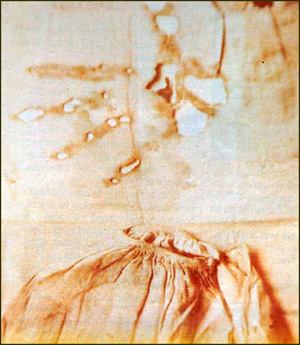
The scorched hand mark on the nightshirt of Joseph Leleux; below, fingerprints on the German prayerbook
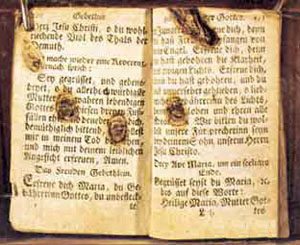
In one exhibit, we see a mark made by the deceased Mrs. Leleux on the sleeve of her son Joseph’s shirt when she appeared to him on the night of June 21, 1789, at Wodecq, Belgium. Her son later related that for 11 consecutive nights, he had been awakened in the night by frightening noises.
On the 12th night, his mother appeared to him to remind him of his duty to have Masses said for her soul in compliance with the terms of a legacy left him by his father. Then she reproached him for his way of life and beseeched him to change his behavior and to practice his Catholic Faith.
Before she disappeared, she placed her hand on the sleeve of his nightshirt, leaving a clear impression. Joseph Leleux was converted and later founded a pious congregation for the laity.
The second demonstration shows a prayer book of George Schitz, which bears the singed fingerprints of his deceased brother Joseph.
He appeared to George on December 31, 1838, at Sarrabe in Lorraine, France, and asked for prayers. Joseph told his brother that he was making expiation in Purgatory for his lack of piety during his life on earth.
Before he disappeared, he touched George’s prayer book, from which his brother had been praying, with his right hand, leaving burn marks.
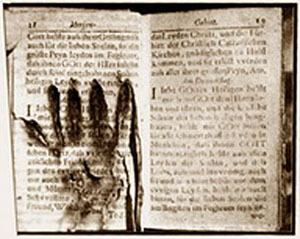
Hand mark left by Marguerite Demmerle
In another exhibit, you can see the mark left on the copy of The Imitation of Christthat belonged to Margherite Demmerlé of Ellinghen Parish in the Diocese of Metz by her mother-in-law.
She appeared to Margherite in 1815, 30 years after her death in 1785, dressed as a pilgrim in the region’s traditional dress. She was coming down the stairs with a sad face, as if she were looking for something, Margherite told her parish priest. When Margherite asked her who she was, she answered, “I am your mother-in-law who died in childbirth 30 years ago. Go on a pilgrimage to the Shrine of Our Lady of Mariental and have two Masses said for me there.”
When Marguerite asked her for a sign, she put her hand on the copy of The Imitation of Christ her daughter-in-law was reading and left burn marks of her fingers. After Marguerite made the pilgrimage and the Masses were said, she appeared to her again to tell her that she had been released from Purgatory. This was all documented by her parish priest.
Since this is November, the month of Poor Souls, next week I will continue the tour of our Piccolo Museo del Purgatorio in Rome and look at several other proofs of the existence of Purgatory housed there. I hope this demonstration will encourage all my readers to say prayers and offer Masses for the souls of their relatives and friends, as well as for all the suffering souls in Purgatory.
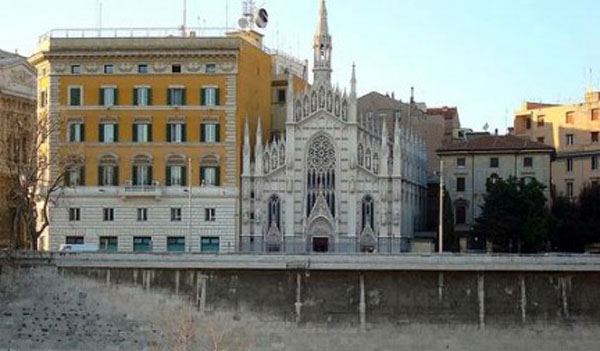
No comments:
Post a Comment